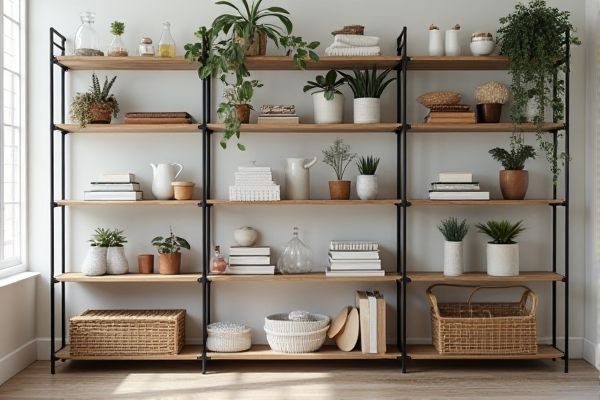
Wire shelving offers superior airflow and visibility, making it ideal for storing items that benefit from ventilation and easy access, while solid shelving provides a sturdier surface perfect for supporting smaller or delicate items. Discover which shelving option best suits your storage needs by reading the rest of the article.
Table of Comparison
| Feature | Wire Shelving | Solid Shelving |
|---|---|---|
| Material | Steel wires, often chrome or powder-coated | Wood, metal, or plastic panels |
| Ventilation | Excellent airflow, reduces moisture buildup | Minimal airflow, prone to moisture retention |
| Weight Capacity | High load-bearing, varies by gauge and design | Varies, generally supports heavy loads depending on thickness |
| Maintenance | Easy to clean, resists dust accumulation | Can trap dust, lint; harder to clean |
| Visibility | Open design allows easy item visibility | Opaque surface hides stored items |
| Installation | Modular, adjustable, easy assembly | May require tools, less adjustable |
| Best Use | Warehouses, kitchens, environment with moisture | Closets, offices, decorative storage |
| Cost | Generally lower cost | Often higher cost due to materials |
Overview: Wire Shelving vs Solid Shelving
Wire shelving offers superior ventilation and visibility, making it ideal for environments requiring airflow and easy access, such as kitchens or warehouses. Solid shelving provides a sturdy, flat surface suited for storing smaller items or liquids that might drip through gaps, ensuring better containment and stability. Choosing the right type depends on your storage needs, weight capacity, and the nature of the materials you plan to organize.
Key Differences Between Wire and Solid Shelving
Wire shelving offers superior ventilation and visibility, reducing dust buildup and allowing air circulation, which is ideal for storage in humid environments. Solid shelving provides a flat, stable surface suitable for smaller or delicate items that require full support without slipping through gaps. Wire shelving is typically lighter and easier to clean, while solid shelving is often more durable and better suited for heavy-duty applications.
Material and Durability Comparison
Wire shelving is typically made from stainless steel or chrome-plated steel, offering high durability and resistance to rust, making it ideal for environments with moisture exposure. Solid shelving, often constructed from wood, MDF, or metal, provides a sturdier surface but may be prone to warping, chipping, or corrosion depending on the material quality and environmental conditions. When choosing your shelving, prioritize wire shelving for excellent ventilation and longevity, while solid shelving offers a more robust, stable platform for heavy or fragile items.
Weight Capacity and Strength
Wire shelving offers excellent weight capacity with typically up to 600 pounds per shelf, making it ideal for heavy-duty storage needs. Solid shelving provides superior strength and stability, supporting unevenly distributed loads without sagging or bending. Your choice depends on whether you prioritize airflow and adjustability with wire shelves or maximum load-bearing strength with solid shelves.
Airflow and Ventilation Benefits
Wire shelving offers superior airflow and ventilation compared to solid shelving, reducing moisture buildup and preventing mold or mildew growth. The open design promotes continuous air circulation, which helps keep stored items fresher and extends their longevity. Your storage spaces benefit from improved hygiene and reduced odors when using wire shelving rather than solid alternatives.
Maintenance and Cleaning Ease
Wire shelving offers superior airflow and prevents dust buildup, making it easier to clean and maintain compared to solid shelving, which can trap dirt and require more frequent wiping. The open design of wire shelves allows spills to pass through, reducing the risk of sticky residue and simplifying sanitation. Your choice should consider the frequency and type of cleaning required to ensure optimal hygiene and upkeep.
Suitability for Different Environments
Wire shelving offers superior airflow and moisture resistance, making it ideal for humid environments like kitchens, bathrooms, and storage areas where ventilation is crucial. Solid shelving provides a stable, flat surface, better suited for environments requiring support for small or delicate items, such as offices or retail displays. Choosing between wire and solid shelving depends on specific environmental factors including humidity levels, item types, and airflow needs.
Installation and Customization Options
Wire shelving offers quick installation with adjustable components that easily accommodate varying shelf heights and configurations, making it highly customizable for diverse storage needs. Solid shelving typically requires more precise measurements and fixed installation, limiting easy adjustments but providing a robust, stable surface ideal for heavy or fragile items. Your choice depends on the balance between flexibility in customization and the need for a sturdy, permanent shelving solution.
Cost Considerations and Longevity
Wire shelving typically costs less upfront and offers better ventilation, reducing moisture buildup that can extend its lifespan in humid environments. Solid shelving tends to be more expensive initially but provides greater durability and weight support, lasting longer under heavy loads and frequent use. You should weigh your budget against the expected wear and environmental factors to decide the best investment for long-term storage needs.
Which Shelving Type Is Right for You?
Wire shelving offers superior ventilation and visibility, making it ideal for storing items that require airflow, such as fresh produce or cleaning supplies. Solid shelving provides a sturdy, flat surface suitable for heavy or small items that might fall through wire gaps, like boxes or electronics. Choose wire shelving for breathable storage and solid shelving for maximum support and protection.
 homyna.com
homyna.com